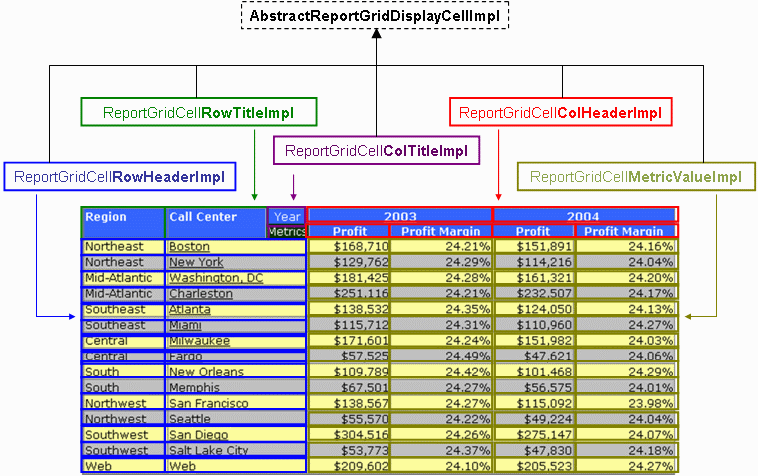Strategy ONE
Cell Rendering Classes
ReportGridTransformImpl is used for generating the visual representation of the data returned by a report in a grid format. It contains many methods, each responsible for different sections of the report grid output. Each of these methods, in turn, eventually delegates the specific HTML generation instructions of the cells content to external classes

The salient features are discussed below:
-
The HTML from each cell in the report grid is generated by a subclass of com.microstrategy.web.app.transforms.AbstractReportGridDisplayCellImpl.
-
AbstractReportGridDisplayCellImpl is an abstract implementation class that is the basis for rendering any cell within the grid such as metric values, column headers, or row headers. The class provides many utility methods to create both the TD tag (including tag attributes) and the content of the cell itself. Subclasses then focus on rendering a particular type of cell such a metric value cell, column header cell, or row header cell, as displayed above. Examples of these subclasses include ReportGridCellColHeaderImpl, ReportGridCellRowHeaderImpl, ReportGridCellColTitleImpl, ReportGridCellRowTitleImpl, and ReportGridCellMetricValueImpl as shown in the diagram above. For additional information, see the API Reference for this class and related subclasses.
The following subclasses of AbstractReportGridDisplayCellImpl in versions prior to MicroStrategy Web 7.5.2 have been deprecated:
-
ReportGridDisplayCellColHeader— Instead of this class, use the ReportGridCellColHeader interface or extend the ReportGridCellColHeaderImpl class.
-
ReportGridDisplayCellRowHeader— Instead of this class, use the ReportGridCellRowHeader interface or extend the ReportGridCellRowHeaderImpl class.
-
ReportGridDisplayCellColTitle— Instead of this class, use the ReportGridCellColTitle interface or extend the ReportGridCellColTitleImpl class.
-
ReportGridDisplayCellRowTitle— Instead of this class, use the ReportGridCellRowTitle interface or extend the ReportGridCellRowTitleImpl class.
-
ReportGridDisplayCellMetricValue— Instead of this class, use the ReportGridCellMetricValue interface or extend the ReportGridCellMetricValueImpl class.
-
-
Creating your own output for a specific cell type requires the creation of a new class that extends the appropriate subclass of AbstractReportGridDisplayCellImpl. For additional information, refer to the Customizing Cell Rendering Classes section.
